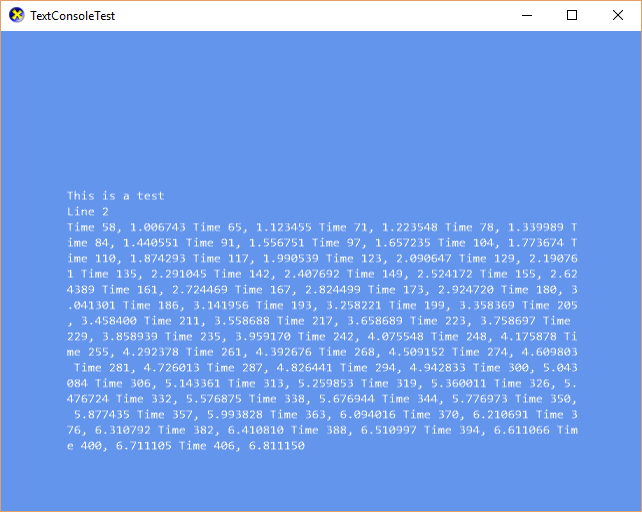-
Notifications
You must be signed in to change notification settings - Fork 513
TextConsole
This is a C++ implementation of a simple console for displaying text. As more text is printed, the text display scrolls up.
class TextConsole
{
public:
TextConsole();
TextConsole(ID3D11DeviceContext* context, const wchar_t* fontName);
void Render();
void Clear();
void Write(const wchar_t *str);
void WriteLine(const wchar_t *str);
void Format(const wchar_t* strFormat, ...);
void SetWindow(const RECT& layout);
void XM_CALLCONV SetForegroundColor(DirectX::FXMVECTOR color) { DirectX::XMStoreFloat4(&m_textColor, color); }
void ReleaseDevice();
void RestoreDevice(ID3D11DeviceContext* context, const wchar_t* fontName);
private:
void ProcessString(const wchar_t* str);
void IncrementLine();
RECT m_layout;
DirectX::XMFLOAT4 m_textColor;
unsigned int m_columns;
unsigned int m_rows;
unsigned int m_currentColumn;
unsigned int m_currentLine;
std::unique_ptr<wchar_t[]> m_buffer;
std::unique_ptr<wchar_t*[]> m_lines;
std::vector<wchar_t> m_tempBuffer;
std::unique_ptr<DirectX::SpriteBatch> m_batch;
std::unique_ptr<DirectX::SpriteFont> m_font;
Microsoft::WRL::ComPtr<ID3D11DeviceContext> m_context;
std::mutex m_mutex;
};
#include "TextConsole.h"
#include <assert.h>
using Microsoft::WRL::ComPtr;
using namespace DirectX;
TextConsole::TextConsole()
: m_textColor(1.f, 1.f, 1.f, 1.f)
{
Clear();
}
TextConsole::TextConsole(ID3D11DeviceContext* context, const wchar_t* fontName)
: m_textColor(1.f, 1.f, 1.f, 1.f)
{
RestoreDevice(context, fontName);
Clear();
}
void TextConsole::Render()
{
std::lock_guard<std::mutex> lock(m_mutex);
float lineSpacing = m_font->GetLineSpacing();
float x = float(m_layout.left);
float y = float(m_layout.top);
XMVECTOR color = XMLoadFloat4(&m_textColor);
m_batch->Begin();
unsigned int textLine = unsigned int(m_currentLine - m_rows + m_rows + 1) % m_rows;
for (unsigned int line = 0; line < m_rows; ++line)
{
XMFLOAT2 pos(x, y + lineSpacing * float(line));
if (*m_lines[textLine])
{
m_font->DrawString(m_batch.get(), m_lines[textLine], pos, color);
}
textLine = unsigned int(textLine + 1) % m_rows;
}
m_batch->End();
}
void TextConsole::Clear()
{
if (m_buffer)
{
memset(m_buffer.get(), 0, sizeof(wchar_t) * (m_columns + 1) * m_rows);
}
m_currentColumn = m_currentLine = 0;
}
void TextConsole::Write(_In_z_ const wchar_t *str)
{
std::lock_guard<std::mutex> lock(m_mutex);
ProcessString(str);
}
void TextConsole::WriteLine(const wchar_t *str)
{
std::lock_guard<std::mutex> lock(m_mutex);
ProcessString(str);
IncrementLine();
}
void TextConsole::Format(const wchar_t* strFormat, ...)
{
std::lock_guard<std::mutex> lock(m_mutex);
va_list argList;
va_start(argList, strFormat);
size_t len = _vscwprintf(strFormat, argList) + 1;
if (m_tempBuffer.size() < len)
m_tempBuffer.resize(len);
memset(m_tempBuffer.data(), 0, sizeof(wchar_t) * len);
vswprintf_s(m_tempBuffer.data(), m_tempBuffer.size(), strFormat, argList);
va_end(argList);
ProcessString(m_tempBuffer.data());
}
void TextConsole::SetWindow(const RECT& layout)
{
m_layout = layout;
assert(m_font != 0);
float lineSpacing = m_font->GetLineSpacing();
unsigned int rows = std::max<unsigned int>(1, static_cast<unsigned int>(float(layout.bottom - layout.top) / lineSpacing));
RECT fontLayout = m_font->MeasureDrawBounds(L"X", XMFLOAT2(0,0));
unsigned int columns = std::max<unsigned int>(1, static_cast<unsigned int>(float(layout.right - layout.left) / float(fontLayout.right - fontLayout.left)));
std::unique_ptr<wchar_t[]> buffer(new wchar_t[(columns + 1) * rows]);
memset(buffer.get(), 0, sizeof(wchar_t) * (columns + 1) * rows);
std::unique_ptr<wchar_t*[]> lines(new wchar_t*[rows]);
for (unsigned int line = 0; line < rows; ++line)
{
lines[line] = buffer.get() + (columns + 1) * line;
}
if (m_lines)
{
unsigned int c = std::min<unsigned int>(columns, m_columns);
unsigned int r = std::min<unsigned int>(rows, m_rows);
for (unsigned int line = 0; line < r; ++line)
{
memcpy(lines[line], m_lines[line], c * sizeof(wchar_t));
}
}
std::swap(columns, m_columns);
std::swap(rows, m_rows);
std::swap(buffer, m_buffer);
std::swap(lines, m_lines);
}
void TextConsole::ReleaseDevice()
{
m_batch.reset();
m_font.reset();
m_context.Reset();
}
void TextConsole::RestoreDevice(ID3D11DeviceContext* context, const wchar_t* fontName)
{
m_context = context;
m_batch = std::make_unique<SpriteBatch>(context);
ComPtr<ID3D11Device> device;
context->GetDevice(device.GetAddressOf());
m_font = std::make_unique<SpriteFont>(device.Get(), fontName);
m_font->SetDefaultCharacter(L' ');
}
void TextConsole::ProcessString(const wchar_t* str)
{
if (!m_lines)
return;
float width = float(m_layout.right - m_layout.left);
for (const wchar_t* ch = str; *ch != 0; ++ch)
{
if (*ch == '\n')
{
IncrementLine();
continue;
}
bool increment = false;
if (m_currentColumn >= m_columns)
{
increment = true;
}
else
{
m_lines[m_currentLine][m_currentColumn] = *ch;
auto fontSize = m_font->MeasureString(m_lines[m_currentLine]);
if (XMVectorGetX(fontSize) > width)
{
m_lines[m_currentLine][m_currentColumn] = L'\0';
increment = true;
}
}
if (increment)
{
IncrementLine();
m_lines[m_currentLine][0] = *ch;
}
++m_currentColumn;
}
}
void TextConsole::IncrementLine()
{
if (!m_lines)
return;
m_currentLine = (m_currentLine + 1) % m_rows;
m_currentColumn = 0;
memset(m_lines[m_currentLine], 0, sizeof(wchar_t) * (m_columns + 1));
}
To use the text console, add a variable to hold the instance:
std::unique_ptr<DX::TextConsole> m_console;
Create it in your initialization:
m_console = std::make_unique<DX::TextConsole>();
// Optionally set a color other than white with something like:
// m_console->SetForegroundColor(Colors::Yellow);
In the equivalent to CreateDeviceDependentResources:
m_console->RestoreDevice(context, L"consolas.spritefont");
For best results, consider using a monospaced (non-proportional) font. Proportional fonts will work, but might introduce additional newlines and will have a 'ragged' right edge.
In OnDeviceLost:
m_console->ReleaseDevice();
In the equivalent to CreateWindowSizeDependentResources, provide the pixel rectangle where you want the console text rendered:
RECT size = m_deviceResources->GetOutputSize();
m_console->SetWindow(SimpleMath::Viewport::ComputeTitleSafeArea(size.right, size.bottom));
Then in your Render function after clearing the screen and drawing whatever background image you want.
m_console->Render();
Wherever you want to add text to the console, use Write, WriteLine, and/or Format:
m_console->WriteLine(L"This is a test");
m_console->WriteLine(L"Line 2");
m_console->Format(L"Time %u, %f ", timer.GetFrameCount(), timer.GetTotalSeconds());
If you want to empty the console text, call Clear.
The text console class is thread-safe using a built-in mutex so that you can call Write, WriteLine, Format, or Clear from other threads. Since it uses a SpriteBatch to render, the Render function itself must be run on the same thread that is using the context you provided.
Since Xbox One XDK apps do not have 'lost device' scenarios, you can avoid using RestoreDevice and ReleaseDevice, and just use the alternate constructor in CreateDeviceDependentResources:
m_console = std::make_unique<DX::TextConsole>(context, L"consolas.spritefont");
The example above uses the Viewport function ComputeTitleSafeArea which is important when rendering text or other UI element on televisions. This is of course optional when rendering on a PC or mobile device and can use the full render viewport instead.
All content and source code for this package are subject to the terms of the MIT License.
This project has adopted the Microsoft Open Source Code of Conduct. For more information see the Code of Conduct FAQ or contact [email protected] with any additional questions or comments.
- Universal Windows Platform apps
- Windows desktop apps
- Windows 11
- Windows 10
- Windows 8.1
- Xbox One
- x86
- x64
- ARM64
- Visual Studio 2022
- Visual Studio 2019 (16.11)
- clang/LLVM v12 - v18
- MinGW 12.2, 13.2
- CMake 3.20
